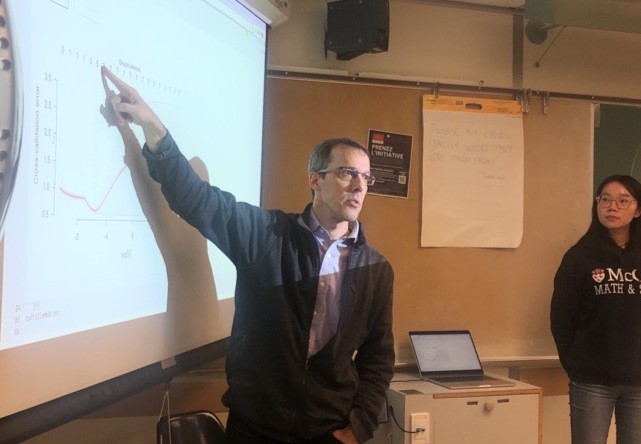
On a cloudy afternoon this past December, a group of McGill students gathered in a downtown Montréal boardroom to give a data science presentation to Citera, a sustainability analytics company. This presentation wasn’t for an internship or any other extracurricular activity – it was part of one of McGill’s newest and most innovative courses: MATH 527, Statistical Data Science Practicum.
It’s a six-credit, two-semester course taught by Dr. José Correa and Professor Eric Kolaczyk of the Department of Mathematics and Statistics. In its first iteration for the 2023-2024 academic year, MATH 527 employs a flipped classroom model, with class sessions focusing primarily on group discussions and projects rather than lectures. Its central organizing principle is the data science life cycle, encountered first in the Fall semester from a statistics-centric perspective, before shifting in the Winter semester to the perspective of a statistician working in the larger data science environment.
“This course concept, developed over a series of years with a larger group of collaborators, provides students with a structured environment in which they learn how theory informs principle and principle informs practice when it comes to the actual doing of statistics and data science,” says Kolaczyk, who serves as director of McGill’s Computational and Data Systems Initiative (CDSI). “The class facilitates a critical intellectual transition that traditionally most students only make upon entering the work environment. At the same time, it provides much-needed consulting and collaboration to McGill researchers and external partners.”
Experiential Learning

The students work in part on consulting projects over the two semesters to put their theoretical knowledge into practice. Each student works on two or three such projects throughout the year, assisting a well-matched subset of the McGill researchers who have requested support through the CDSI’s Data Science Solutions Hub (DaS2H).
Launched in 2022, DaS2H supports McGill faculty, research staff, graduate students, and undergraduates by offering advice regarding applied statistics, computing methodologies, and data analytics. People who bring their projects to DaS2H have problems, aims, and challenges that can be much more complex than the theoretical course material to which students may be accustomed. To succeed in these projects, MATH 527 students must approach them with an understanding of the fluidity of real-life data science work outside the classroom.
In addition to these academic projects, students also work with two industry partners like Citera; one in the fall semester and one in the winter semester.
“From the students’ perspective, partner projects expose them to real-life workplace scenarios that prepare them for employment in their fields,” said Correa. “From the perspective of the partners, it brings them academic expertise that can help them understand their processes better and improve their business output.”
For the statistics students taking the course, the vast majority of whom are undergraduates, it offers them the opportunity to step out of the familiar theoretical territory of many of their other courses and work collaboratively in small groups to solve these real-life problems.
“This is the first class I’ve taken that only has 20 people in it, so it’s really nice to get to know my classmates and work together,” said Lisa Zhang, a statistics and computer science student who worked on another industry partner project with TD Insurance. “The projects are very hands-on as well, which is a nice change from the theory-heavy classes that make up the majority of my degree.”
Producing real-life solutions
In the lead-up to each group’s presentation to their respective industry partner, the students practiced their presentations and went through their findings in the classroom. Working with the Citera students while Correa worked with the TD group, Kolaczyk provided real-time feedback on the group’s findings, analyses, and how they communicated their recommendations.
“My biggest takeaway from working with Citera is that teamwork and communication are key.” said Nora Kollokian, a statistics major who is also pursuing a minor in social studies of medicine. “Bouncing ideas off each other to come up with the best plan of action and communicating them with Citera while being receptive to feedback was a great way for us to handle this project.”
At the start of the first semester, Kolaczyk and Correa emphasized one key point above all else: MATH 527 students work on real-life projects with real-life data, producing solutions that are meaningful to real people. From their work on the DaS2H projects to their industry partnerships with companies like Citera, these students have the unique opportunity to both learn inside the classroom and affect meaningful change outside of it.
